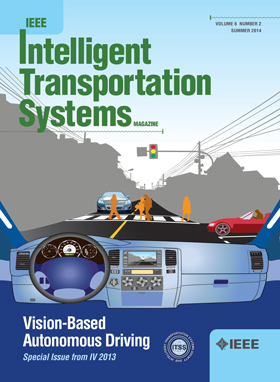End-Point Drive and Reverse Enhanced Decoding- Based Traffic Participants Trajectory Prediction Under Bird’s Eye View
IF 8.4
1区 工程技术
Q1 ENGINEERING, CIVIL
IEEE Transactions on Intelligent Transportation Systems
Pub Date : 2025-04-16
DOI:10.1109/TITS.2025.3554714
引用次数: 0
Abstract
Trajectory prediction under Bird’s Eye View (BEV) refers to predicting the movement intention of agents based on the historical observation trajectories, which is of great significance for autonomous driving, driving safety and social navigation. The traffic prediction trajectory is multimodality with multiple reasonable trajectories and various prediction time, which often suffer complex agents interaction, cumulative errors and a large number of agents. To overcome these problems, we explore the BEV-based traffic participants trajectory prediction problem and propose the novel End-point Drive and Reverse Enhanced Decoding Network (EDRED-TPNet), based on the mechanisms of end-point driving and reverse enhanced decoding. Firstly, the Encoder based on Dynamic Spatio-temporal Graph and Multimodality Coding Fusion (ST-MC-Encoder) are constructed to effectively represent complex traffic scenario with changeable agents, encode social interactions with historical trajectories, social interaction, future trajectory and multimodality. Secondly, the End-Point Drive Module is proposed to predict the end point before predicting the complete trajectory, thus providing more accurate trajectory prediction; Lastly, to further improve the long-term prediction performance, the Reverse Enhanced Decoder (RE-Decoder) is proposed to fuse forward and reverse hidden state vectors to obtain diverse trajectories that conform to physical and social acceptability rules. We build the first AAV-captured Trajectory Prediction Dataset (UTP-Dataset) for traffic participants trajectory prediction. Experimental results show that the proposed methods can fulfill the multi-target trajectory prediction task in complex traffic scenarios and achieve high performance.基于端点驱动和反向增强解码的鸟瞰交通参与者轨迹预测
BEV (Bird 's Eye View)下的轨迹预测是指基于历史观察轨迹对智能体的运动意图进行预测,对于自动驾驶、驾驶安全以及社会导航都具有重要意义。交通预测轨迹是多模态的,具有多个合理轨迹和多种预测时间,往往存在复杂的智能体交互、累积误差和大量的智能体。为了克服这些问题,我们探索了基于bev的交通参与者轨迹预测问题,并提出了基于端点驱动和反向增强解码机制的新型端点驱动和反向增强解码网络(EDRED-TPNet)。首先,构建基于动态时空图和多模态编码融合的编码器(ST-MC-Encoder),有效表征具有可变主体的复杂交通场景,对历史轨迹、社会互动轨迹、未来轨迹和多模态进行社会互动编码;其次,提出了终点驱动模块,在预测完整轨迹之前预测终点,从而提供更准确的轨迹预测;最后,为了进一步提高长期预测性能,提出了反向增强解码器(RE-Decoder),融合正向和反向隐藏状态向量,以获得符合物理和社会可接受规则的多种轨迹。我们建立了第一个aav捕获的轨迹预测数据集(UTP-Dataset),用于交通参与者的轨迹预测。实验结果表明,该方法能够完成复杂交通场景下的多目标轨迹预测任务,并取得了较高的性能。
本文章由计算机程序翻译,如有差异,请以英文原文为准。
求助全文
约1分钟内获得全文
求助全文
来源期刊

IEEE Transactions on Intelligent Transportation Systems
工程技术-工程:电子与电气
CiteScore
14.80
自引率
12.90%
发文量
1872
审稿时长
7.5 months
期刊介绍:
The theoretical, experimental and operational aspects of electrical and electronics engineering and information technologies as applied to Intelligent Transportation Systems (ITS). Intelligent Transportation Systems are defined as those systems utilizing synergistic technologies and systems engineering concepts to develop and improve transportation systems of all kinds. The scope of this interdisciplinary activity includes the promotion, consolidation and coordination of ITS technical activities among IEEE entities, and providing a focus for cooperative activities, both internally and externally.
 求助内容:
求助内容: 应助结果提醒方式:
应助结果提醒方式:


